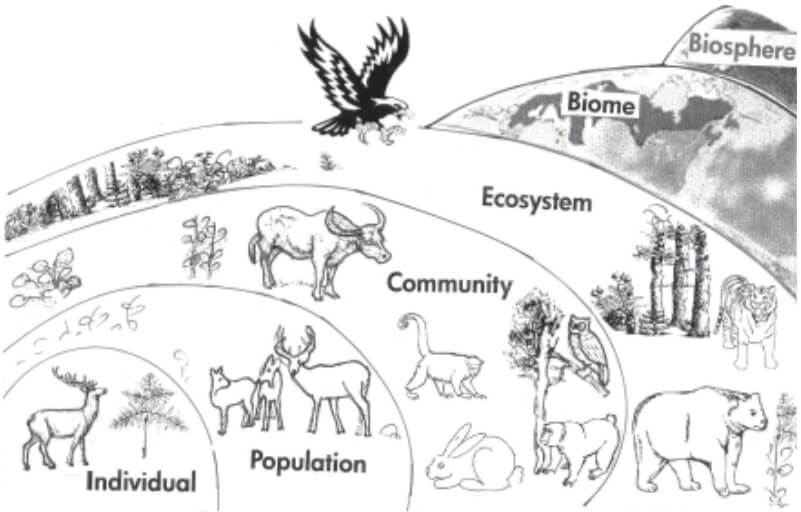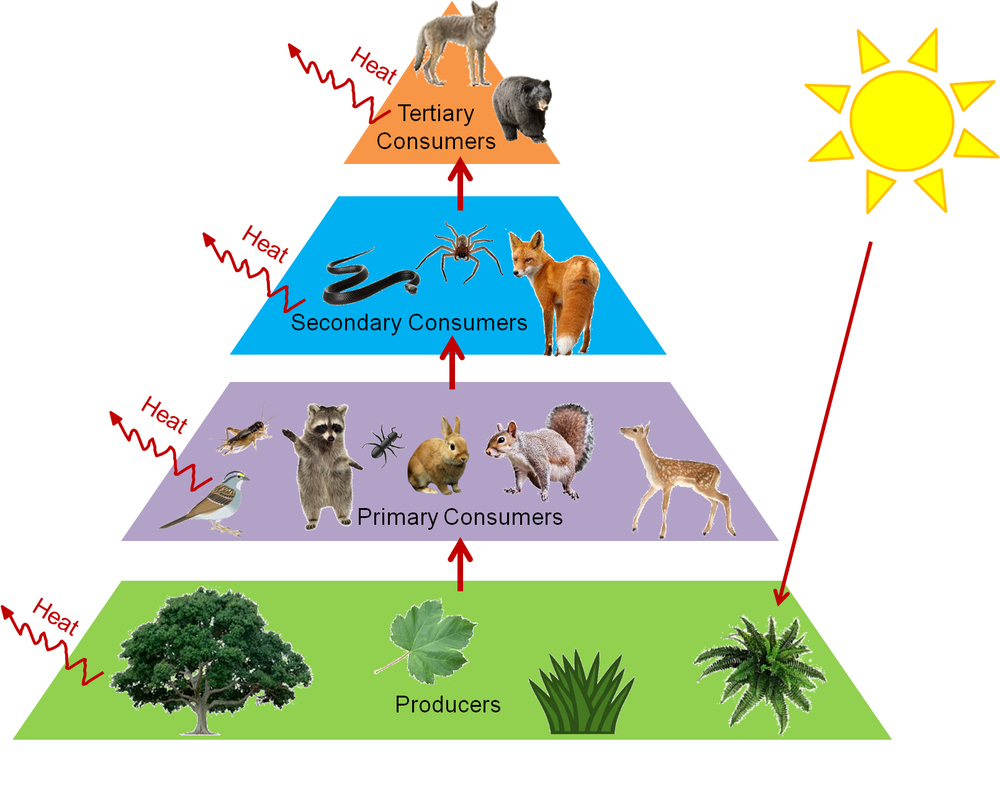All organisms such as plants, animals, microorganisms and human beings as well as the physical surroundings interact with each other and maintain a balance in nature. All the interacting organisms in an area together with the non-living constituents of the environment form an ecosystem. Ecosystems can be visualised as a functional unit of nature, where living organisms interact among themselves and also with the surrounding physical environment. Ecosystems varies greatly in size from a small pond to a large forest or a sea.
In 135, Sir Arthur Tansely was the first ecologist who used the term ecosystem to explain the tangible relationships that exist between organisms in the biological world. The concept of an ecosystems introduced by him viewed each locale or habitat as an integrated whole.
In general terms, the word ecosystem is made up of “eco” and “system”. Eco means the habitat and “system” means a complex set of interconnected components or processes forming a whole. The word system also indicates a functional property and hence an ecosystem is considered as a functional unit of nature.

Classification of Ecosystem:
Ecosystems can be broadly divided into two main categories as terrestrial and aquatic ecosystems. Major terrestrial or land ecosystems include grasslands, forests and deserts etc while major aquatic ecosystems includes ponds, lakes, rivers, estuaries, oceans, coastal and inland wetlands etc.
Terrestrial Ecosystems
Terrestrial ecosystems are exclusively land-based ecosystems. There are different types of terrestrial ecosystems distributed around various geological zones. They are as follows:
- Forest Ecosystems
- Grassland Ecosystems
- Tundra Ecosystems
- Desert Ecosystem
Forest Ecosystems
- A forest ecosystem consists of several plants, animals and microorganisms that live in coordination with the abiotic factors of the environment.
Grassland Ecosystems
- In a grassland ecosystem, the vegetation is dominated by grasses and herbs. Temperate grasslands, savanna grasslands are some of the examples of grassland ecosystems.
Tundra Ecosystems
- Tundra ecosystems are devoid of trees and are found in cold climate or where rainfall is scarce. These are covered with snow for most of the year. The ecosystem in the Arctic or mountain tops is tundra type.
Desert Ecosystems
- Deserts are found throughout the world. These are regions with very little rainfall. The days are hot and the nights are cold.
Aquatic Ecosystem
Aquatic ecosystems are ecosystems present in a body of water. These can be further divided into two types, namely:
- Freshwater Ecosystems
- Marine Ecosystems
Freshwater Ecosystems
- The freshwater ecosystem is an aquatic ecosystem that includes lakes, ponds, rivers, streams, and wetlands.
Marine Ecosystems
- The marine ecosystem includes seas and oceans. These have a larger salt content and greater biodiversity in comparison to the freshwater ecosystem.
Components of ecosystem:
The components of any ecosystem can be categorised into two main types. They are:
- Abiotic components, which consist of chemical substances and physical conditions that support life in the ecosystem, and
- Biotic components, which include all living organisms.
Abiotic Components of Ecosystem:
Abiotic components are the inorganic & non-living parts of the world. The abiotic components form the physical environment of an ecosystem include factors such as energy, elements, inorganic compounds, dead organic matter and climate.
The inorganic elements and compounds found in the ecosystem consist of all nutrients such as nitrates, phosphates and sulphates, water, carbon dioxide and oxygen etc.
The organic compounds that form a part of the abiotic components are largely the by products resulting from the different activities of organisms or their death and decay. All inactive or dead organic matter and dissolved organic matter are derived either from plants or animals.
Biotic Components
The biotic components of ecosystems include the plants, animals and microbes i.e., total living community. They can be classified into two main groups of organisms − the autotrophs (producers) and the heterotrophs (consumers).
The autotrophs have the ability to synthesize their own food from simple inorganic compounds. Example, green plants and certain bacteria and algae etc. They are also known as producers.
The heterotrophs do not produce their own food. They depend on the producers directly or indirectly to obtain their energy requirements. The heterotrophs include two groups of organisms, namely consumers and decomposers.
The consumers are those that feed on the living tissues of plants or animals or both. Based on this there are three types of consumers.
- Herbivores, or primary consumers. In terrestrial ecosystem typical herbivores are insects, birds and mammals. Primary consumers also include parasites (fungi, plants or animals) of plants. In aquatic ecosystems (freshwater and marine) the typical examples of herbivores are: small crustaceans and mollusks and some fish.
- Carnivores, are the meat eaters and form the secondary consumers and tertiary consumers.
- Omnivores, are animals that have flexible food habits as they eat plants, (therefore are herbivores or primary consumers) and animals (therefore are carnivores or secondary and tertiary consumers). Humans are good examples of omnivores.
Decomposers are also known as saprotrophs. Mostly, these are microscopic and are heterotrophic in nature. Decomposer organisms obtain their energy and nutrients by degrading dead organic matter.

Characteristics of Ecosystems:
Although there are variations of the physical environment among different ecosystems, ecologists have been able to recognize four basic characteristics that are common to any ecosystem. They are:
- Links to other ecosystems
- Structural complexity
- Resilience and
- Dynamic stability
Links with Other Ecosystems:
No ecosystem exists alone. They are interconnected via inputs and outputs that act as links. The outputs of one ecosystem such as nutrients, gases, water etc., may be inputs of another ecosystem in the same landscape. For example a river receives many inputs from the terrestrial ecosystem through which it flows.
Structural Complexity:
The structural complexity of an ecosystem is a combination of many factors. They include the following:
- Species composition of plants, animals and microbes of the ecosystem
- Variations in the environmental factors such as seasonal changes, tidal changes, nutrient levels, sediments, rainfall etc.
- Presence of distinctive interacting habitats within the ecosystem like mangroves, sea, and grass beds etc.
Resilience
Resilience of an ecosystem is its ability to return to its original state after being exposed to a stressful situation. Resilience is a common feature in all ecosystems, but the degree of resilience depends on the intensity of the stress to which the ecosystem is exposed.
Dynamic Stability
Ecosystems are not static. They always undergo changes and are termed as dynamic systems. Although changes take place very often both in living and non-living factors, the natural ecosystems are dynamically stable if their future states are determined by their current state that is their internal characteristics with very few external influences affecting their equilibrium.
Functions of ecosystem
Ecosystems are complex dynamic system. They perform certain functions. These are:-
- Energy flow through food chain
- Nutrient cycling (biogeochemical cycles)
- Ecological succession or ecosystem development
- Homeostasis (or cybernetic) or feedback control mechanisms.
Food Chains & Food Web
A food chain describes the route by which energy and nutrients are transferred from the autotrophs through a series of organism that consume and are consumed. Food chain is a linear sequence of organisms which starts from producer organisms and ends with decomposer species.

The sharing of food by consumers in natural ecosystems leads to food chains being interconnected with one another forming a network. The resulting complex network of interlinked food chains is referred to as a food web. Food web is a connection of multiple food chains. In simple words, food chain follows a single path whereas food web follows multiple paths.

Types of Food Chains
Within any ecosystem, either terrestrial or aquatic, two major types of food chains can be identified. They are Grazing food chains and Detritus food chains.
Grazing food chains:
- The grazing food chain begins with green plants at its base as producers. Therefore, plants act as the source of energy for the primary consumers.
- Ocean food chains are among the longest, up to five links, in contrast to food chains in the forest, which mostly consist of three or rarely four links.
Detritus food chains:
- The detritus food chains start from dead and decaying organic matter of animal and plant bodies known as detritus. Here, the detritus act as the source of energy for the primary consumers termed as detritus consumers.
Supplementary food chains
Supplementary food chains in an ecosystem are formed by parasites and scavengers. Parasites can be primary, secondary or higher consumers that feed on a plant or an animal known as a host, over an extended period of time. They usually feed on their host without killing it, at least not immediately as the other consumers do; but cause harm to the host.
Parasites that are found inside the body of the host are known as endoparasites. In contrast, those such as lice and ticks that are attached to the outside of the body of their host are called ectoparasites.
Usually parasitic food chains are highly complicated because of their life cycle patterns. The food chains also exist among parasites themselves. For example, a parasitic protozoan Leptomonas in turn parasitizes fleas that parasitize mammals and birds.

